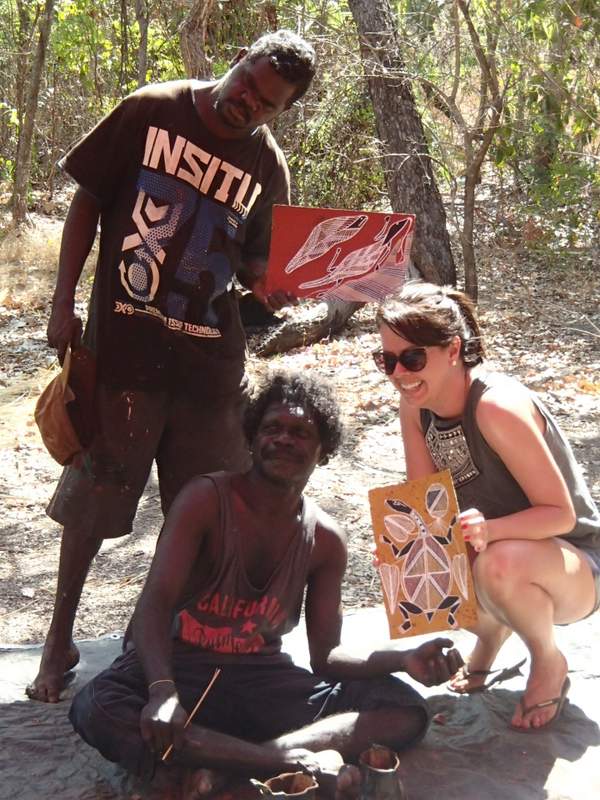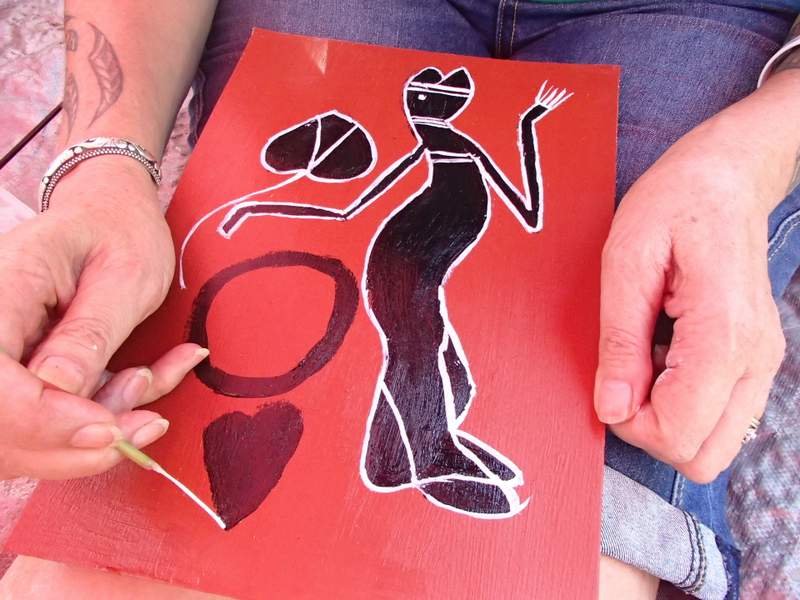[soundcloud url="https://api.soundcloud.com/tracks/205550788" params="color=ff5500&auto_play=false&hide_related=false&show_comments=true&show_user=true&show_reposts=false" width="100%" height="166" iframe="true" /]
Audio recorded and transcript prepared by Andy Peart:
Larry Bangarr talks about the "Thick Lines—Thin Lines" weekly tourist activity that has been going for a few years every Saturday at the Border Store or Merl Campground during the dry season, organised by Injalak Arts & Crafts and funded by Kakadu National Park. Interview by Andy Peart.
[00:00:00.00] AP: Na-ngale ngudda?
What is your name?
[00:00:06.01] LB: Ngaye Bangardi. Bangardi Namarrirn
My subsection name is Bangardi, and my clan group is Marrirn.
[00:00:10.19] AP: Dja ngudda dja nungka nawu Nadjalama, Nakangila, ngune-djarrkdurrkmirri bolkkime kore Border Store.
And you and Amos (Nakangila subsection, Djalama clan group) are working together here at the Border Store?
[00:00:21.20] LB: Yoh.
Yes.
[00:00:22.05] AP: Njale - njale ngune-durrkmirri?
What work do you both do?
[00:00:24.02] LB: Djurra ngane-bimbun, ngane-bimbun bikos kore kabirrimh-re nawu tourist ngan(d)ih-nan.
We paint pictures and finish them so tourists can came and watch.
[00:00:31.20] AP: Yiben-bukkan?
You show them how you paint.
[00:00:33.05] LB: Ngarrben-bukkan.
I show them.
[00:00:35.11] AP: Dja yiddok ngurrben-bengyolyolme bu bim, rarrk yika, yiman?
And do you explain to them about the art, about the cross hatching etc?
[00:00:41.15] LB: Ngarrben-bengyolyolme laik ngarrih-bimbun, ngarrben-bengyolyolme, wanjh ngarrbenh-marneyime, ngarri-benwon, la copy ngandi-yime.
We explain about things, about what we are painting, and we give them paper so they can copy us.
[00:00:55.23] AP: Yikahwi kabirri-bimbun bedman?
Sometimes the visitors paint their own pictures?
[00:01:01.29] LB: Yoh, bu yiman bu kabirri-bimbun yiman kabirrih-lenh learn kabirri-yime yiman bu bedman wanjh kabirri-bimbun. Kabirri-marnbun.
Yes, they paint pictures, following what we do
[00:01:09.25] AP: Man-yilk...
Sedge grass (Cyperas javanicus)?
[00:01:11.09] LB: Man-yilk, manih kun-dalk.
The sedge grass we call man-yilk, here.
[00:01:17.01] AP: Mah, and njale kabirribimbun? Mayh, or djenj?
What do they paint? Animals, fish?
[00:01:23.07] LB: Mayhmayh, o djenj, o kinga, ngalmangiyi. Bu laik ngarri-bimbun namekke kabirrimh-re kabirri-nan namekke turis, ngandidjawan ngadberre: "Njale nakka ngurri-marnbun?" ngarri-ngeybun namekke. En ngarrben-won djurra, "Ngurri-bimbun yiman nanih _____ ngarri-bimbun ngad.” Wanjh copy ngandi-yime, kabirri-marnbun.
Birds, fish, crocodiles, long-necked turtle. We paint them, then we get the tourists to see what we painted. They ask us “what do you call that?” and we tell them the name. We give them paper to paint on, and tell them “you have a go at painting this animal like how we did it”. So they copy us and make their own paintings.
[00:01:48.08] AP: And , dja wurdwurd?
And kids?
[00:01:49.23] LB: Wurdwurd warridj. Wurdwurd mak ngarrben-bukkan.
Kids too, we show them how to paint.
[00:01:53.00] AP: Kabirri-marnedjare.
They love it.
[00:01:54.20] LB: Kabirri-djare ba kabirri-bimbun bu ngandi-nan, copy ngandi-yime.
They like to paint when they see us and copy us.
[00:01:59.09] AP: Yikahwi na-wern tourists.
Sometimes many tourists are here having a look.
[00:02:01.17] LB: Yoh, na-wern.
Yes, lots.
[00:02:03.07] Yikahwi nabuyika artists kabirri-durrkmirri?
Sometimes different artists come to work here?
[00:02:10.01] LB: Bu birri-wern mak yika kore mak ngarrben-bawon Kunbarlanja. Ngarrben-bawong, ngane-djalbokenh konda ngaye Bulanj nganem-wam kondah ngane-bimbimbun bu laik nani Balanda ngarrbenh-nan, ngandih-nan. Ngandih-nan la ngarrben-nan. La ngarrbenh-bukkan.
There are many other artists, but just two of us come here and we left everyone else back at Gunbalanya – today myself and Bulanj [Amos] – to see the tourists and show them how we paint.
[00:02:26.20] AP: Every Saturday.
[00:02:28.21] LB: Every Saturday.
[00:02:29.27] AP: Mah. Konda kore Border Store.
Here at the Border Store.
[00:02:32.26] LB: Konda Border Store.
Here at the Border Store.
[00:02:35.02] AP: Dja yiddok yikahwi nawu bim nawu tourist kabirri-bimbun na-mak? Yikahwi?
Sometimes the visitors paint good pictures?
[00:02:43.09] LB: Yika bu yiman kabirri-wernhborlbme, wanjh kunukka na-mak kabirri-marnbun.
Some of them learn to paint reasonably well and their pictures turn out ok.
[00:02:49.20] AP: Yikahwi na-warre.
Sometimes terrible.
[00:02:51.29] LB: Yika na-warre, yoh.
Yes, sometimes they're awful.
[00:02:53.25] AP: Mah, and last one bolkkime.
And today is the last Saturday for the year.
[00:02:57.24] LB: Bolkkime nganem-wam, last one mane. Kaluk might be next year kare.
Today we've come, and its the last one. Then maybe next year it will happen again.
[00:03:04.02] AP: Next year, mah.
Next year, ok.
[00:03:04.26] LB: Next year manu bu nganem-wam, Bulanj, wanjh bu ngane-durndeng kaluk, djal next year-wi kare.
That's it now, so next year we'll come back for this work.
[00:03:11.24] AP: Mah. Kamak, bonj.
Ok, good, we can finish it here.
[00:03:13.24] LB: Mah. Kunekke, bobo.
Ok, that's the story then. Bye.
Bim: Bangardi Larry dja Bulanj Amos kabene-bimbukkan tourist bedberre kore Border Store.
Photos: Larry Bangarr and Amos Nganjmirra from Injalak Arts and Crafts teaching Bininj painting to tourists at the Border Store.
(photos by Andy Peart)
Bonj
That is all.



Speak Your Mind